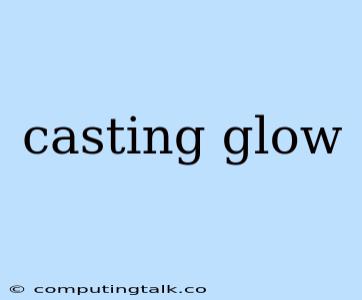Achieving that Enchanting Casting Glow: A Guide to Cinematic Lighting
Have you ever watched a film and been captivated by the way light seems to dance across the actors, highlighting their features and creating a mesmerizing atmosphere? This magical effect is often referred to as casting glow, and it's a key element in achieving a truly cinematic look.
But what exactly is casting glow and how can you replicate it? Let's delve into the world of light and shadow to uncover the secrets of this enchanting technique.
What is Casting Glow?
In essence, casting glow is a type of lighting that creates a soft, warm halo around a subject, often with a slight golden hue. It's characterized by a gentle diffusion of light, producing a dreamy and almost ethereal quality.
Think of the classic scene in a film noir where a character is lit by a single spotlight, casting their silhouette against a dark background. That soft, luminous outline is a prime example of casting glow.
How to Achieve Casting Glow:
1. Light Source: The key to achieving casting glow lies in choosing the right light source. Ideally, you'll want to use a soft, diffused light, such as a softbox, umbrella, or even a large piece of white fabric. These light modifiers help to create a gentle, even light that wraps around the subject.
2. Distance: The distance between the light source and the subject is crucial. A closer light source will create a more dramatic casting glow, while a further light source will produce a softer, more subtle effect. Experiment with different distances to find the look that best suits your vision.
3. Angle: The angle of the light is also essential. Side lighting or backlighting is often used to create casting glow, as it helps to accentuate the subject's contours and create a sense of depth. However, don't be afraid to experiment with different angles to find what works best for your scene.
4. Color Temperature: While not always necessary, adding a slight warmth to your light source can enhance the casting glow effect. A warm light temperature, often in the range of 3200K to 4300K, can create a more inviting and cinematic atmosphere.
5. Reflectors: To further enhance the casting glow effect, try using reflectors to bounce light back onto your subject. A white reflector can create a soft, even light, while a gold reflector can add a warm, golden hue to the casting glow.
Tips for Replicating Casting Glow:
- Pay attention to the background: A dark or contrasting background will help the casting glow stand out.
- Use multiple light sources: Combining different light sources can create a more complex and interesting casting glow.
- Experiment with different diffusers: Explore various diffusers to achieve the desired level of softness and warmth.
- Think about the overall mood: The casting glow should enhance the emotion and atmosphere of your scene.
Common Mistakes to Avoid:
- Using harsh, direct light: This will create harsh shadows and a less desirable casting glow.
- Placing the light source too close to the subject: This can lead to an uneven, overly dramatic casting glow.
- Forgetting about color temperature: A mismatched color temperature can create an unnatural look.
Conclusion:
Mastering casting glow is an art form, requiring practice and experimentation. It's about understanding light, its properties, and how it interacts with the subject to create a desired effect. By applying these principles, you can achieve a truly enchanting and cinematic look that will captivate your audience. Remember, the key is to have fun with the process and explore different lighting techniques until you find your own unique style.
